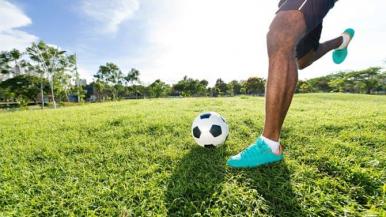Hip pain is all too common, with everyone from recent college graduates to grandparents at risk.
But why you are suffering can be difficult to pinpoint. To get the proper diagnosis, the best clues are the type of pain and where it is located.
Here, Shane Nho, MD, MS, a hip preservation specialist at Rush, looks at seven common causes of hip pain — including some might surprise you.
1. Core muscle injury (a.k.a. sports hernia or athletic pubalgia)
If you feel pain in your groin area, it might be a core muscle injury, such as a strain or tear of muscles or other soft tissues in the lower abdomen.
This injury is quite common in weekend warriors — especially those who play sports involving a lot of extreme twisting and turning, but who aren't as athletically conditioned as they need to be.
Treatment: Resting the affected muscles for several weeks can help. You may also require surgery to repair the torn muscle by a general surgeon.
2. Bursitis
If it hurts on the outside of your hip, thigh and/or buttocks, you can probably blame bursitis — the inflammation of the pillow-like fluid sacs that keep tendons and muscles from rubbing directly against bone.
"Though walking for a long time or climbing stairs can make it worse, bursitis usually is not associated with activity-related pain. It just hurts day to day," Nho says. "Even lying on that side when you sleep can make it hurt."
Bursitis becomes more common as we age, and is especially prevalent in people over 60.
Treatment: At home, try rest, putting ice compresses on the area and taking anti-inflammatory and pain medications. Sometimes, your doctor may give you a cortisone injection to reduce inflammation.
3. Tendonitis
If you're active, and your hip flexor (the group of muscles that lets you bring your knee and leg toward your body) or groin are tender when you touch or move them, you may have tendonitis.
"Straining or over-using tendons — the cords that attach the muscle to the bone — creates repeated minor injuries that eventually lead to muscular imbalances in the hip," Nho explains. "People who do very specific activities over and over, like kicking a soccer ball, can be at risk for this severe pain."
Treatment: Treatment options are similar to bursitis.
4. Labral tears
The labrum is the ring of cartilage that surrounds the hip socket and ensures the ball of the thighbone stays in place. When it tears — often in athletes and ballerinas — it causes pain in the hip or groin and limits movement, creating a sensation that the hip is locking, catching or clicking.
"The pain tends not to go away," Nho says. This injury is common in people with anatomic abnormalities that make the hip too shallow or hips with impingement (see below), or in those iwho previously injured their hips.
Treatment: A type of minimally invasive surgery is used to repair the labrum and shave down the misshaped bone. This procedure corrects the hip's alignment, relieving pain and protecting the joint.
The pain you feel in your hip could actually be coming from elsewhere in your pelvis.
5. Gynecological or pelvic floor issues
The pain you feel in your hip could actually be coming from elsewhere in your pelvis.
"The pelvis contains many systems, and everything is jammed in there, close together. Sometimes, there can be confusion about where the pain is coming from," Nho says.
If the pain is limited to your groin and coincides with ovulation or your period, the cause could be endometriosis or uterine fibroids rather than a problem with the hip. Urological and gastrointestinal issues, such as gastroenteritis and prostate cancer, could also cause pain that's easily mistaken for a hip injury.
Treatment: Visit your primary care physician for a complete workup. Depending on the diagnosis, they may refer you to another specialist, such as a gynecologist or a gastroenterologist, for treatment.
6. Hip impingement
Nho treats hip pain in many younger people who do high-intensity athletics, such as Tough Mudder races, CrossFit or barre classes.
"These intense activities can actually cause the hip bones to fuse in an abnormal shape and limit movement," Nho says. This is called hip impingement, or femoral acetabular impingement (FAI). Not only does it hurt, but it also increases the risk of premature osteoarthritis.
Treatment: Physical therapy can help and is often the first line of treatment. Ultimately, surgery to move the hipbones to unlock them might be required.
7. Osteoarthritis
This is a very common cause of a daily, dull pain in the hip. With osteoarthritis, your joints become stiff and swollen due to inflammation and breakdown of cartilage, causing pain and deformity.
Recent studies show that osteoarthritis results when the hip bones are not formed perfectly, making them not fit together neatly. This eventually causes them to rub against each other, Nho says.
Being highly active — running marathons or playing high-impact sports like basketball — can increase your chances of getting osteoarthritis. Add aging, obesity or traumatic injury and the pain can become disabling.
Treatment: Along with rest, ice, steroids and over-the-counter pain and anti-inflammatory medications, more aggressive treatments include stem cell therapy and surgery, from hip resurfacing to total hip replacement.
Keep your hips healthy
To help prevent hip pain, Nho suggests the following:
- Control your weight
- Stretch or do yoga regularly
- Strengthen your core
- Get annual check-ups
- Exercise regularly, but make sure to do exercises that are appropriate for your age and physical condition
If your hip pain is intense or long lasting, visit your primary care physician. You might then be referred to a specialist for a closer look.




